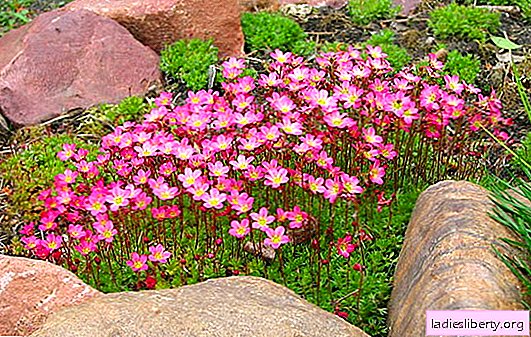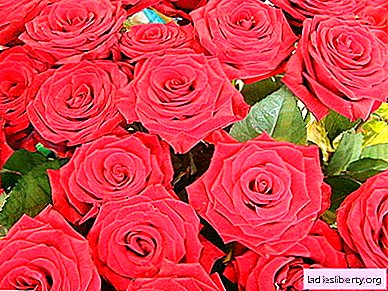
Saxifraga (Saxifraga) is a stunted plant belonging to the Saxifraga family.
Most species are perennial, but in nature one is found - biennial varieties.
Distributed flower in a temperate climate, characterized as an unpretentious plant.
Description and types of saxifrage
Saxifraga from Latin translates as "breaking a stone." The name is due to the fact that the flower grows in the crevices of stones, penetrating deep into the rhizomes and destroying them over time.
The appearance of the plant depends on the variety, on average, saxifrage does not exceed 70 cm in height. Rounded leaves create rosettes at the rhizome itself. The appearance of the leaf may be fleshy or velvety.
Saxifraga begins to bloom for 2-3 years of life. Flowers form symmetrical panicles or umbrellas of pink, white, yellow, green or burgundy.
Types of saxifrage:
• Paniculate (aizoon) - a low plant, densely covering the soil. Flowers can be different (white, pink, yellow), differ in the presence of small red dots.
• Wicker (stolonifera) - white flowers collected in rosettes with a complex inflorescence.
• Hard-leaved (aizoides) - creeping appearance with bright yellow flowers.
• Arends (arendsii) - an evergreen plant forming a continuous carpet.
• Supernotifolia (oppositifolia) - large, pink flowers. Forms cushion thickets.
In addition to the above species, there are: bluff, hawk-leaved, cesium, granular and other varieties.
Saxifrage: planting, breeding, site selection
Saxifrage can be propagated in 3 ways: by seeds, cuttings and dividing the bush.
Seed propagation stages:
1. Time for planting seeds - April.
2. Seeds should be kept in the cold. They are laid out in a small container with earth, lightly sprinkled with soil and placed in the refrigerator for 2 weeks.
3. A container with planting material is placed on the windowsill and covered with a film.
4. After the first shoots, the film coating is removed. If the seeds have not germinated within 2 weeks, then this will not happen.

5. When the seedlings form strong 3-4 leaves, they are dived (transplanted into separate containers).
6. Each individual pot should contain 1 bush of saxifrage. Landing in the open ground is carried out in June along with an earthen lump. The distance between the bushes is 8-10 cm.
Cuttings - The easiest way to reproduce. To do this, cut a single rosette of leaves. The largest leaves are chosen without signs of disease or damage. The process is placed in a container of wet sand until roots are formed. Then the seedling is transplanted into a pot of earth, and when it finally takes root (2-3 weeks), the saxifrage can be planted in the ground. A similar method of reproduction is carried out in spring or summer.
Division propagation produced after the final flowering of saxifrage. The bush is abundantly watered with water, dug up, trying not to damage the roots, and divided into 2 or more seedlings. Each divide must have roots and green mass. Slices on the mother plant sprinkled with earth and plant the bush back. Young seedlings are planted in pre-prepared wells, dug with soil and watered.

Saxifrage Transplant
A flower transplant from one place to a new one can be carried out in cases:
• if part of the plants is infected with the disease;
• in the case when the flower has grown over the entire territory of the flowerbed, and is deprived of the opportunity to reproduce further;
• if the roots of the room saxifrage occupied the entire pot;
• the plant has been growing in the same place for more than 5-6 years.
Choosing a place and soil
Given the natural environment for the growth of saxifrages, it is necessary to plant it in stony soil, preferably on a slope. The soil should pass moisture and air well. Sand and stones are added to the ground. For better growth, the soil is mixed with turf and humus.
The plant does not like direct sunlight, but the shadow negatively affects the development of the bush. The ideal place is a partial shade area. If the saxifrage is planted in pots and grown indoors, it is better to keep it on the eastern or western windowsills.
How to properly grow a saxifrage: flower care
Being a strong flower capable of destroying stones, a saxifrage is not particularly demanding in care. Both experienced gardeners and beginners can cope with the cultivation of such a plant.
• Temperature. The optimum temperature for comfortable growth of saxifrage is 20-25 degrees in the summer. For winter, these indicators vary between 12-15 degrees.
• Humidity. The moisture indicators surrounding the plant should be within elevated limits. Garden and indoor saxifrage must be systematically sprayed with standing water. This should be done in the morning or evening, otherwise drops of water on the leaves under the influence of sunlight will turn into lenses and contribute to the formation of burns.
• Lighting. Saxifrages need moderate light. The plant does not tolerate direct rays of the sun and poorly develops in the shade. If you plant it on a slope whose side does not extend east or west, you will have to artificially shade the flowers. The north side is not the best place to land.
• Watering. Saxifrage should be watered systematically, preventing the soil from completely drying out. Despite the fact that the plant loves moisture, stagnation of water may not have the best effect (for example, lead to rotting of the roots). That is why it is important to provide the saxifrage with soil drainage or a constant outflow of water. Watering is best done with settled or rainwater.

• Winter preparations. After flowering, dried flowers need to be removed, this will facilitate the process of preparation for the winter for the plant. Since the saxifrage does not tolerate frost well, in anticipation of frosts it should be covered with dry foliage or spruce branches.
Saxifrage Feeding
Systematic top dressing is extremely important for saxifrage. Without fertilizers, it develops poorly, draws leaves and inflorescences, becomes thinner, and looks painful.
They feed the plants from February to October. You can use complex fertilizers. Refuse should be from nitrogen-based top dressing.
Fertilizer is applied in a liquid state during irrigation. Dosage depends on each specific remedy. Keep in mind that saxifrage does not tolerate oversaturation with fertilizers, so the dosage indicated on the package of a particular product should be halved.
The first feeding is carried out a week after planting. Then fertilizers are applied 2 times a month. In winter, top dressing is reduced or completely eliminated. Only indoor flowers can be fertilized with a complex agent, not more than 1 time in 2 months.
Pests, diseases and possible problems with saxifrage. Care and treatment
Saxifrage is not a painful flower, but, nevertheless, can be attacked by pests and some diseases.
The most common pests and diseases:
• Spider mite. Signs are the presence of a white web, yellowed leaves. As a prophylaxis, spraying is used. If the flower becomes infected, the damaged leaves are torn off, the bush itself is washed under running water (from hoses, if it grows in the garden) and treated with anti-ticks.

• Rust, mushroom stains. They occur with excess moisture. Treatment is copper based.
• Powdery Mildew. Also the result of excessive moisture. The diseased plant will have to be removed, the rest should be treated with preparations: propiconazole, bitertanol or azoxystrobin.
• Worms. The way out is manual removal and anti-colic drugs.
• Aphid - an insect of white, brown or green color. Treatment is pyrimor.
Possible problems in the development of a saxifrage during care that does not meet the requirements
1. Lack of flowering, elongated leaves - lack of nutrients.
2. Plaque on the roots, spots on the leaves - decay as a result of excess moisture.

3. Slowing growth - lack of sunlight or fertilizer.
4. Pale, fading leaves - excess light, fever.
5. Tarnished veins on the leaves - little sunlight.
6. Dark spots on the leaves - sunburn.
The saxifrage in planting and care is an unpretentious flower that can decorate any garden. Covering the surface with a continuous carpet with bright colors, the plant envelops flower beds, alpine slides or just patches of land. It is often used in landscape designs, decorated with ponds, gazebos and garden paths. In addition, this amazing flower can be grown indoors, which is very convenient for those who like to care for plants, but do not have a personal plot.











